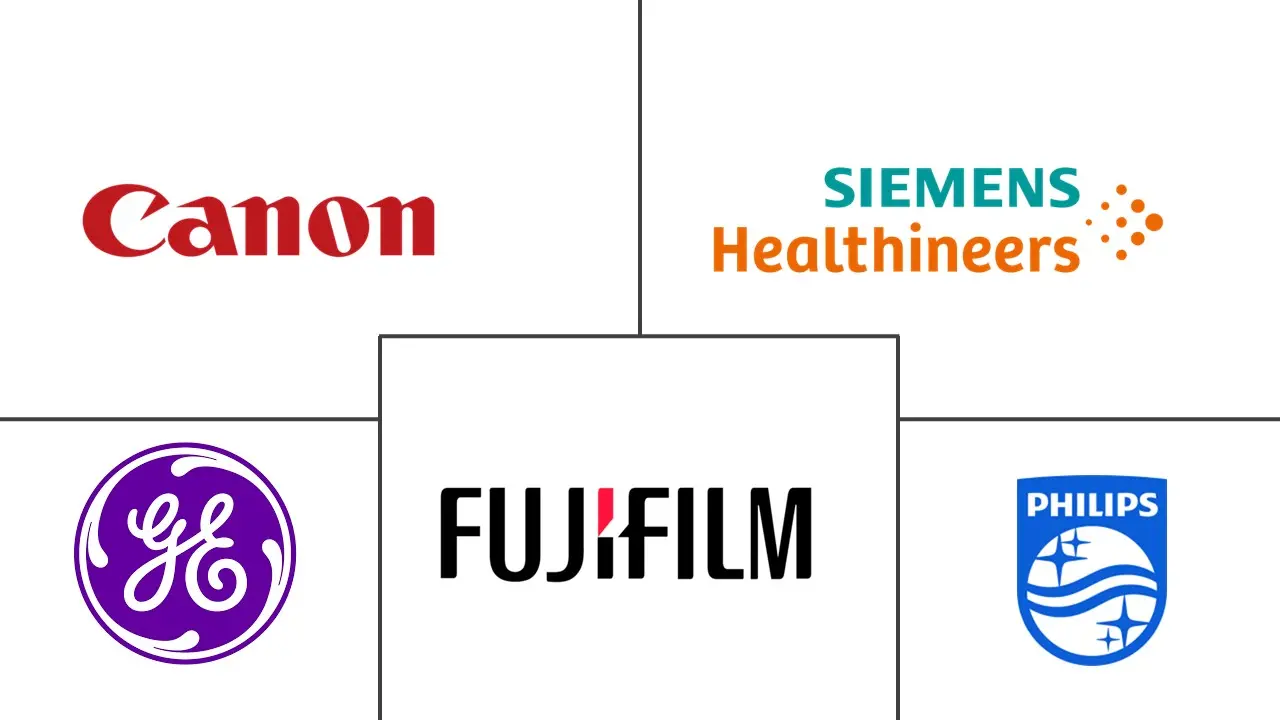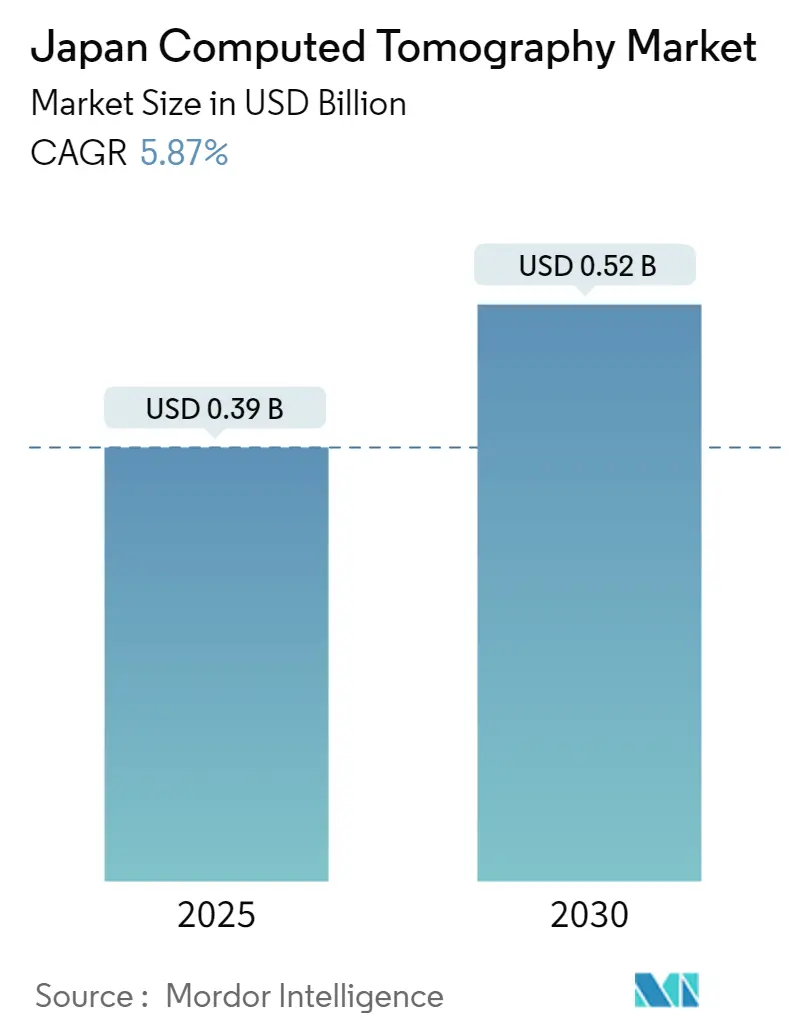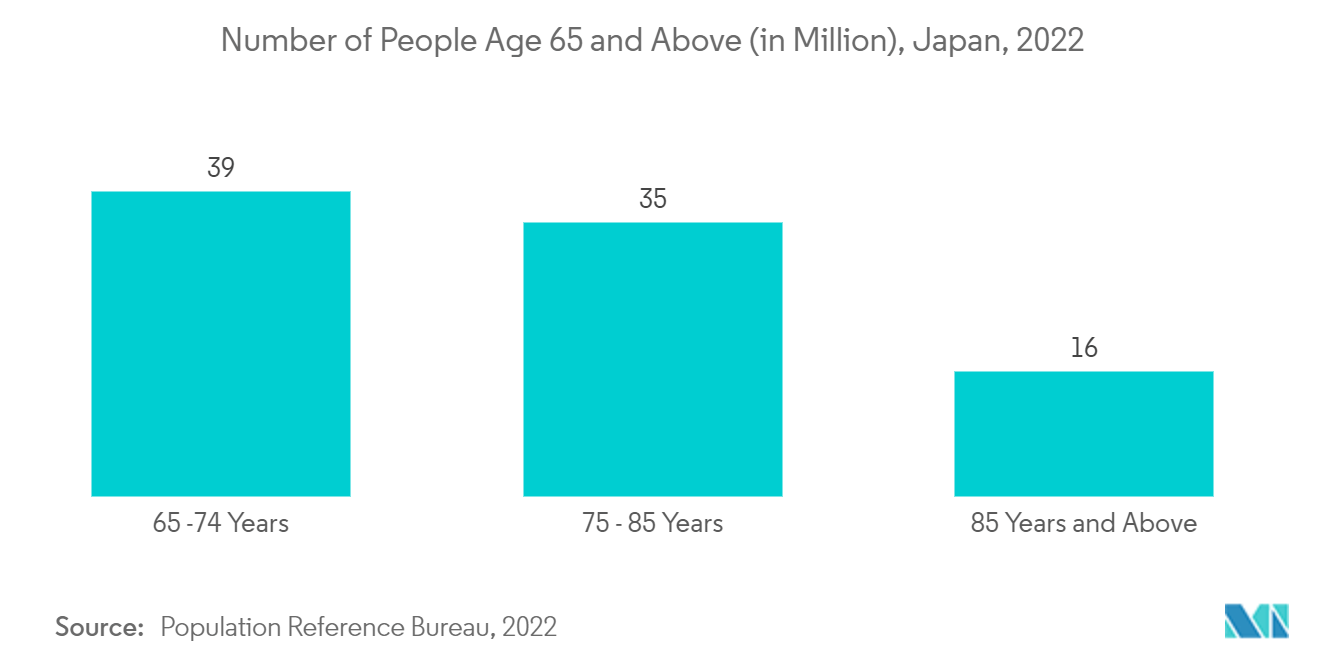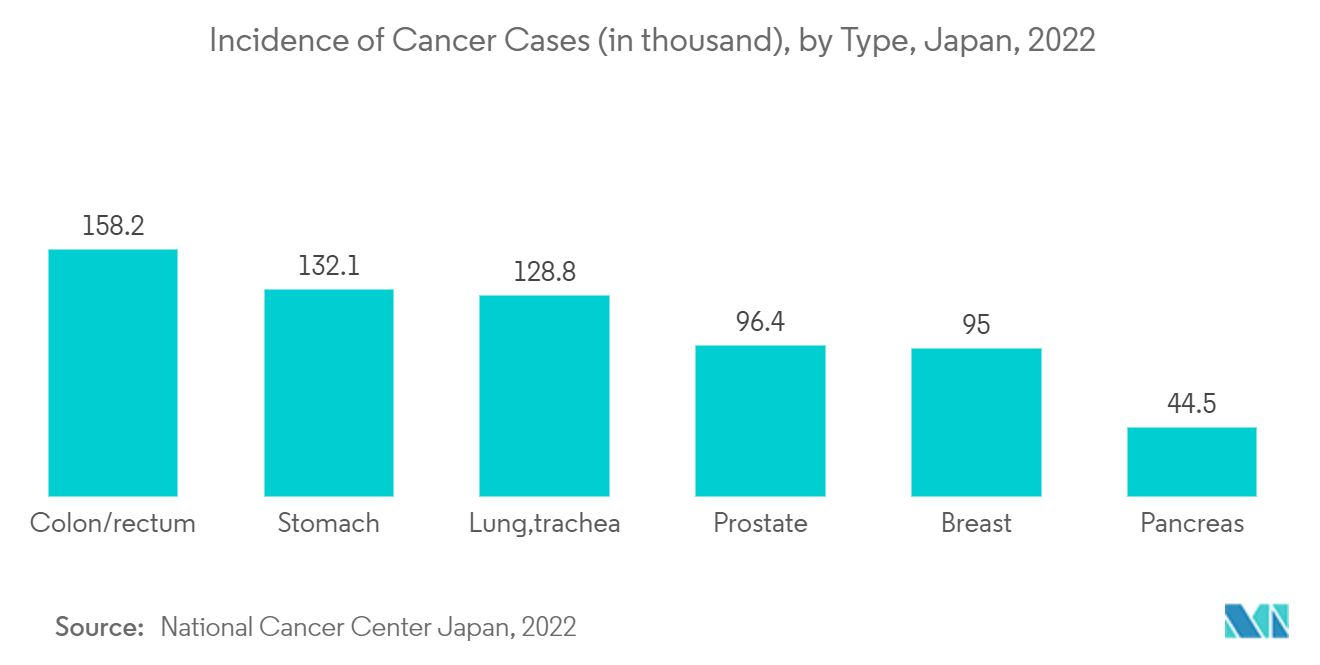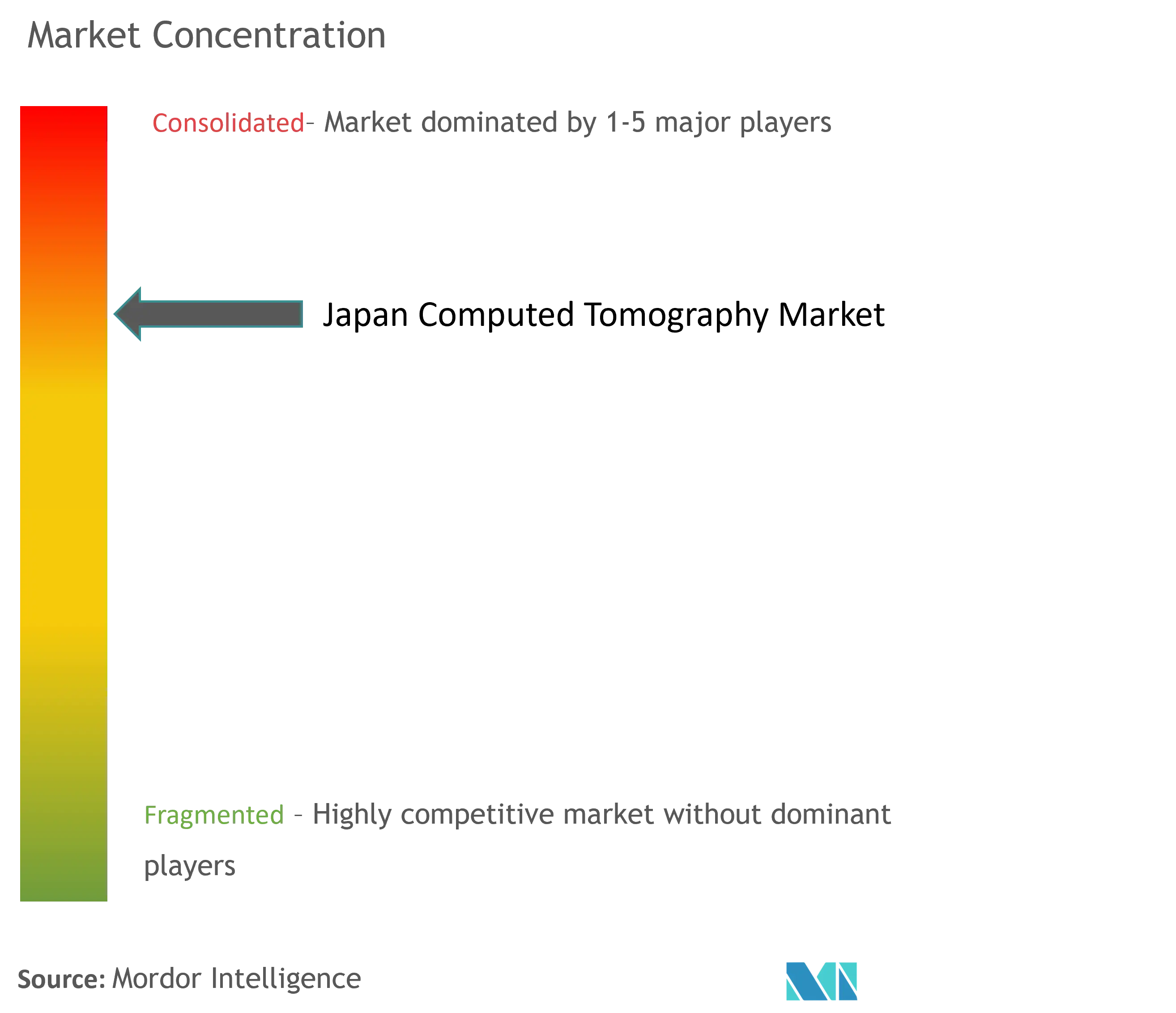Japan Computed Tomography Market Analysis
The Japan Computed Tomography Market size is estimated at USD 0.39 billion in 2025, and is expected to reach USD 0.52 billion by 2030, at a CAGR of 5.87% during the forecast period (2025-2030).
The COVID-19 pandemic had a significant impact on the market studied. The healthcare system witnessed enormous challenges due to the COVID-19 pandemic. All outpatient treatments were postponed or restricted during the COVID-19 pandemic to reduce the risk of viral transmission, as most chronic therapies were regarded as non-urgent. However, with the advent of the COVID-19 infection, lung imaging became a major part of COVID-19 diagnostics as it helped diagnose the severity of the disease in the affected population. According to the study published in the Keio Journal of Medicine in May 2022, CT showed 68% sensitivity and 57% specificity. Patients with false-positive (FP) CT results have typically been found to have illnesses that mimic COVID-19, such as interstitial lung disease. Decision curve analysis showed that CT imaging had limited clinical relevance. Thus, the CT scan used declined for the COVID-19 diagnosis. However, the market has recovered well owing to the resumption of diagnostic procedures and manufacturing activities, and it is expected to witness a similar trend over the coming years.
Major factors driving the growth of Japan's computed tomography market include the increasing burden of chronic diseases such as cancer, cardiovascular disease, orthopedic diseases, and diabetes, among others. For instance, according to the study published in the Journal of Alzheimer's Diseases in March 2021 in Japan, it was predicted that there will be between 6.5 million and 7 million and 8.5 million and 11.5 million people with dementia in 2025 and 2060, respectively. Likewise, in Japan, 50-75% of dementia cases are caused by Alzheimer's disease (ADD). In addition, according to the World Alzheimer Report 2022, about 43% of those with mild dementia, 67% of those with moderate dementia, and 90% of those with severe dementia were institutionalized in the country. Thus, a significant burden of neurological diseases is expected to boost demand for diagnostic imaging such as computed tomography, thereby boosting the market's growth.
The major players are undertaking various strategic initiatives. These include mergers, acquisitions, collaborations, partnerships, and product launches. For instance, in August 2021, Canon Medical Systems Corporation initiated a collaborative research effort with the National Cancer Centre Japan, the Exploratory Oncology Research & Clinical Trial Centre, and EAST Hospital to develop a next-generation diagnostic imaging system using photon-counting computed tomography (PCCT).
Thus, all the factors above, such as the growing burden of chronic diseases and strategic activities by the market players, are expected to boost market growth over the forecast period. However, the high cost associated with the CT scan procedures and equipment may restrain market growth over the forecast period.
Japan Computed Tomography Market Trends
The Diagnostic Centers Segment is Expected to Witness Significant Growth in End Users
The rising prevalence of dental and cardiovascular conditions, cancers, and strategic measures undertaken by many centers are contributing to the growth of the computed tomography market in Japan. The country's considerable healthcare investment is likely to drive market growth.
Furthermore, Fujifilm announced in April 2021 that it had invested USD 11 billion in its healthcare division. In addition, in March 2021, the company acquired Hitachi's diagnostic imaging business. As a result of such strategic developments, diagnostic imaging services in Japan are poised to grow. These advancements will increase the use of diagnostic imaging devices such as CT, X-rays, and ultrasound, among others. This is expected to increase demand for CT imaging services at hospitals and diagnostic centers, propelling segment growth.
The increasing awareness of health concerns from chronic disease burden has significantly increased the demand for diagnostic imaging tests in Japan. Additionally, various companies and government agencies are taking initiatives to spread wellness awareness and minimize the prevalence of chronic diseases, such as Cancer in Japan. For instance, in September 2022, Kao Group launched a Pink Ribbon Campaign to raise awareness for early detection of breast cancer. Additionally, in September 2022, on World Alzheimer's Day, Eisai Co., Ltd.'s headquarters in Japan announced the release of two dementia awareness videos. This video will create awareness of neurological diseases and screening of diseases, thereby boosting the segment growth.
Therefore, due to various factors, the diagnostic centers segment is expected to grow over the forecast period of the study.
Oncology Segment is Expected to Grow with Healthy CAGR over the Forecast Period
Oncology is defined as the diagnosis and treatment of tumors and cancers. Oncology is one of the leading causes of morbidity and mortality. Therefore, the need for imaging in the diagnosis of cancer is high within the region, as it is used to detect tumors and other abnormalities, determine the extent of the disease, and evaluate the effectiveness of treatment. The incidence of cancer cases within the region is elevating the growth of the oncology segment.
According to the 2022 statistics published by Ganjoho, about 378,600 new cancer cases (218,900 cases in males and 159,700 cases in females) were reported in Japan in 2021. In addition, as per the same source, lung cancer was the leading site (24% for males), followed by rectum/colon cancer (13%), stomach cancer (12%), pancreas (8%), and liver cancer (7%). Thus, the high burden of cancer among the population raises the need for early diagnosis, which in turn is anticipated to fuel the demand for imaging devices such as CT scans, MRIs, and others, hence propelling the segment's growth.
Moreover, product launches and technological advancements by major players are also fueling market growth. For instance, in November 2021, NeuroLogica's BodyTom Elite, the company's mobile, full-body, 32-slice CT (computed tomography) scanner, will be available for purchase in Japan. BodyTom Elite offers additional flexibility by allowing point-of-care CT imaging and reducing the risks associated with moving critically ill patients to radiology.
Thus, all the aforementioned factors are expected to boost segment growth over the forecast period.
Japan Computed Tomography Industry Overview
The computed tomography (CT) market is consolidated due to the presence of a few major players, including Canon Medical Systems Corporation, Koninklijke Philips NV, GE Healthcare, and Siemens Healthineers. These major players hold a significant share in the industry. Most players focus on bringing technologically advanced products into the market to acquire the maximum market share.
Japan Computed Tomography Market Leaders
-
GE Healthcare
-
Koninklijke Philips N.V.
-
Canon Medical Systems
-
Siemens Healthineers
-
Fujifilm Holdings Corporation
- *Disclaimer: Major Players sorted in no particular order
Japan Computed Tomography Market News
- April 2023: Canon Inc. announced that Canon and the National Cancer Center Japan (NCC) have begun clinical research employing a next-generation X-ray CT system with photon-counting computed tomography (photon-counting CT, PCCT).
- April 2022: Fujitsu and the Southern Tohoku General Hospital announced the launch of a joint research project with Fujitsu Japan Limited and FCOM CORPORATION on AI technology for the early detection of pancreatic cancer from computed tomography (CT) scans without contrast agent (non-contrast CT scans).
Japan Computed Tomography Industry Segmentation
As per the report's scope, computed tomography (CT) is an imaging process that customizes special X-ray equipment to generate a sequence of exhaustive images or scans of areas inside the body. Japan Computed Tomography (CT) Market is Segmented by Type (Low Slice, Medium Slice, and High Slice), Application (Oncology, Neurology, Cardiovascular, Musculoskeletal, and Other Applications), End User (Hospitals, Diagnostic Centers, and Other End-Users). The report offers the value (in USD) for the above segments.
| By Type | Low Slice |
| Medium Slice | |
| High Slice | |
| By Application | Oncology |
| Neurology | |
| Cardiovascular | |
| Musculoskeletal | |
| Other Applications | |
| By End-User | Hospitals |
| Diagnostic Centers | |
| Other End-Users |
Japan Computed Tomography Market Research FAQs
How big is the Japan Computed Tomography Market?
The Japan Computed Tomography Market size is expected to reach USD 0.39 billion in 2025 and grow at a CAGR of 5.87% to reach USD 0.52 billion by 2030.
What is the current Japan Computed Tomography Market size?
In 2025, the Japan Computed Tomography Market size is expected to reach USD 0.39 billion.
Who are the key players in Japan Computed Tomography Market?
GE Healthcare, Koninklijke Philips N.V., Canon Medical Systems, Siemens Healthineers and Fujifilm Holdings Corporation are the major companies operating in the Japan Computed Tomography Market.
What years does this Japan Computed Tomography Market cover, and what was the market size in 2024?
In 2024, the Japan Computed Tomography Market size was estimated at USD 0.37 billion. The report covers the Japan Computed Tomography Market historical market size for years: 2019, 2020, 2021, 2022, 2023 and 2024. The report also forecasts the Japan Computed Tomography Market size for years: 2025, 2026, 2027, 2028, 2029 and 2030.
Our Best Selling Reports
Japan Computed Tomography Industry Report
Statistics for the 2025 Japan Computed Tomography market share, size and revenue growth rate, created by Mordor Intelligence™ Industry Reports. Japan Computed Tomography analysis includes a market forecast outlook for 2025 to 2030 and historical overview. Get a sample of this industry analysis as a free report PDF download.

